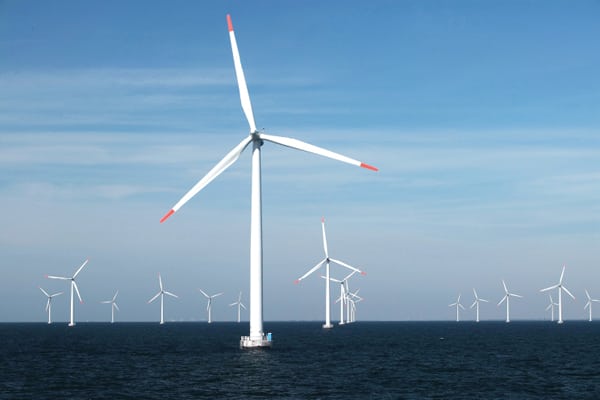Wind Energy Soars Around the World
Denmark put into operation its 12th offshore wind farm this October. The €440 million Rødsand 2 wind farm, a 90-turbine installation with a nameplate capacity of 207 MW, was erected for owner E.ON by Siemens Energy—both German firms—over a mere 122 days (Figure 1). The wind farm joins Rødsand I, a 72-turbine installation that began operating nearby in the Baltic Sea in 2003.
 |
| 1. A drop in the ocean. E.ON began operation of 90 wind turbines at the Rødsand 2 wind farm in the Baltic Sea this October. The Siemens-supplied 2.3-MW turbines are 150 meters high and arranged in five curved rows consisting of 18 turbines each. The turbines are being connected to energy company SEAS-NVE’s grid with 33-kV underwater cables. Courtesy: E.ON |
Rødsand 2 brings Denmark’s offshore capacity to almost 720 MW, according to the Danish Energy Agency. It is the third installation brought online by E.ON this year, following the 180-MW Robin Rigg wind farm—one of the largest in the UK—and Germany’s Alpha Ventus, the world’s first deepwater wind farm. For Siemens, which supplied the 2.3-MW turbines, Rødsand 2 is its 16th offshore wind project to date.
And it doesn’t end there: E.ON is looking to expand its onshore and offshore capacity to 10,000 MW by 2015. Projects include collaborations with Siemens to put up 175 3.6-MW wind turbines with Danish partner DONG Energy and Abu Dhabi firm Masdar for the London Array project in the UK—the world’s first 1-GW wind farm. Denmark also has another major offshore wind farm in the pipeline: DONG Energy is developing the $1.65 billion Anholt wind farm, a 400-MW installation in the North Sea. The 3.6-MW Siemens turbines for that project are expected to be erected by 2012.
According to the Global Wind Energy Council (GWEC), these and other projects contributed to a surge in wind energy’s growth around the world. This year alone, 40 GW of new capacity were added, and the world’s installed wind power capacity is expected to reach close to 200 GW by the end of 2010. Between 2010 and 2014, global wind power could reach more than 400 GW, GWEC said, spurred by new installations in Latin America and in northern and sub-Saharan Africa.
“We do expect the US market to be down this year as the low level of orders we saw during the financial crisis work their way through the system. On the other hand, stronger growth in China will make up for this, and the European market is very stable,” said GWEC Secretary General Steve Sawyer. “Overall, wind energy continues to be a growth market, weathering the economic crisis much better than some analysts had predicted.”
The outlook doesn’t seem as promising for all wind companies, however. Danish wind turbine manufacturer Vestas in late October announced it would close five production plants across Scandinavia, shifting its focus to Spain instead. The decision, which follows the company’s move of manufacturing away from the UK last year, was made when an expected surge in demand for wind power in Europe did not materialize, Vestas said.
The American Wind Energy Association released its third-quarter results on Oct. 29 and noted that only 1,634 MW had been installed during the quarter, down 72% from 2009 and the lowest since 2006.
—Sonal Patel is POWER’s senior writer.